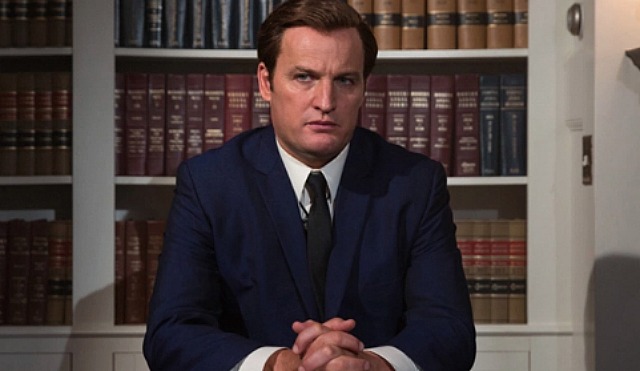Thirteen months ago I threw some praise at a 5.11.16 draft of Taylor Allen and Andrew Logan‘s Chappaquiddick. I tore through it in no time. It’s the kind of well-finessed backroom melodrama that I love — no bullshit, subdued emotions, no tricks or games. It’s tense and well-honed, and, like I said on 8.18.16, a nightmare that had me shaking my head and muttering “Jesus H. Christ”.
Like the script, the film (which I saw this morning at 8:30 am) is a damning, no-holds-barred account of the infamous July 1969 auto accident that caused the death of Kennedy family loyalist and campaign worker Mary Jo Kopechne, and which nearly destroyed Sen. Edward Kennedy‘s political career save for some high-powered finagling and string-pulling that allowed the younger brother of JFK and RFK to more or less skate.

Jason Clarke as the late Senator Edward M. Kennedy in John Curran’s Chappaquiddick.
Just about every scene exudes the stench of an odious situation being suppressed and re-narrated by big-time fixers, many of whom are appalled at Ted’s behavior and character but who do what’s necessary regardless.
There’s no question that director John Curran, dp Maryse Alberti and editor Keith Fraase are dealing straight, compelling cards, and that the film has stuck to the ugly facts as most of us recall and understand them, and that by doing so it paints the late Massachusetts legislator and younger brother of JFK and RFK in a morally repugnant light, to put it mildly.
All along I’ve been hoping that Curran would just shoot the script efficiently, minus any kind of showing off or oddball strategies that might diminish what was on the page. This is exactly what he’s done. Curran has crafted an intelligent, mid-tempo melodrama about a weak man who commits a careless, horrible act, and then manages to weasel out of any serious consequences.
Chappaquiddick may not be the stuff of monumental cinema (stylistically it feels like a respectable HBO-level thing), but it’s a frank account of how power works (or worked in 1969, at least) when certain people want something done and are not averse to calling in favors. EMK evaded justice by way of ingrained subservience to the Kennedy mystique, a fair amount of ethical side-stepping and several relatively decent folks being persuaded to look the other way.
Under-40 types who’ve never heard of the Chappaquiddick incident or who’ve never bothered to read the Wikipedia summary would do well to see this.
How good is Clarke? Good enough, I’d say. There’s no way to “like” the character he’s playing, of course, and the 48 year-old Clarke is 11 years older older than EMK was at the time of the tragedy, and so at times he seems a little too creased and doughy. But the resemblance is nonetheless striking, and I bought what Clarke was doing for the most part. And thank God he doesn’t overdo the Kennedy accent.
But Dern’s performance as the legendary paterfamilias is the most searing, and all the more striking because he has no lines (he says one word over the phone — “alibi”) and does it all with his damning eyes plus a single slap across the chops. I can easily see some Best Supporting Actor action.
In the draft I read Kennedy and Kopechne kiss (on-camera) and even do the deed (off-camera). That’s been cut out. As I noted last year, the depiction of Kopechne’s slow, agonizing death from suffocation inside Kennedy’s submerged, upside-down 1967 Oldsmobile is agonizing to read. The movie tones this scene down; I’d be lying if I said I wasn’t relieved.
The Chappaquiddick incident all but destroyed Kennedy’s reputation, of course, but he quickly recovered. The honor and lustre were gradually restored. For nearly four decades after the tragedy Ted was a fully respected and renowned legislator, an ally of former President Barack Obama and vice versa, a health care advocate, a godfather, a diplomat and an operator who knew how to play the game and get things done.
But after Chappaquiddick opens (later this year or early next?) the name of Edward M. Kennedy will be sullied yet again.
It all boils down to this: “John Farrar, captain of the Edgartown Fire Rescue unit and a diver who recovered Kopechne’s body, repeatedly alleged that Kopechne died from suffocation rather than from drowning. He based this hypothesis upon the posture in which he found the body and the body’s relative position to the area of an ultimate air pocket in the overturned vehicle.
“Farrar also asserted that Kopechne would have likely survived if a more timely rescue attempt had been conducted. Farrar located Kopechne’s body in the well of the backseat of the overturned submerged car. Rigor mortis was apparent, her hands were clasping the backseat, and her face was turned upward.
Farrar gave the following testimony: “It looked as if she were holding herself up to get a last breath of air. It was a consciously assumed position…. She didn’t drown. She died of suffocation in her own air void. It took her at least two hours to die, [and maybe] three or four. I could have had her out of that car twenty-five minutes after I got the call. But he [Ted Kennedy] didn’t call.
“Had I received a call within five to ten minutes of the accident occurring, and was able, as I was the following morning, to be at the victim’s side within twenty-five minutes of receiving the call, in such event there is a strong possibility that she would have been alive on removal from the submerged car.”












